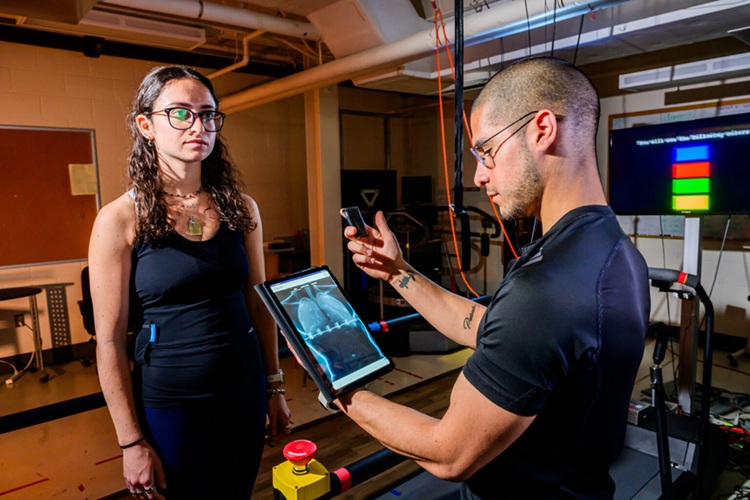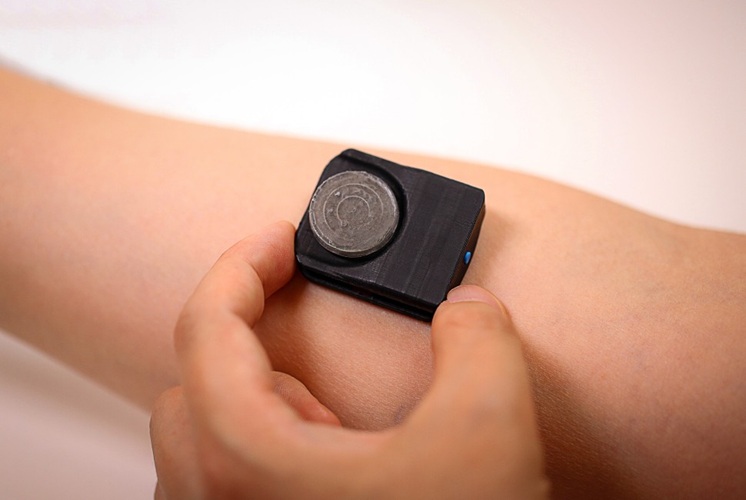Pelvic Floor Muscle Stimulator Treats Urinary Incontinence
|
By HospiMedica International staff writers Posted on 29 Nov 2018 |

Image: Research shows that muscle stimulation can reduce incontinence (Photo courtesy of Atlantic Therapeutics).
An externally worn stimulation device treats the root cause of stress urinary incontinence (SUI), rather than just managing the symptoms.
The Atlantic Therapeutics (Galway, Ireland) Innovo system is a non-invasive transcutaneous muscle exerciser, resembling a pair of cycling shorts, which uses electrical stimulation to deliver 180 precise, complete contractions to the pelvic floor muscles. During each 30-minute exercise session, the system strengthens and re-educates the network of muscles that control bladder function. A hand-held controller connected to the shorts allows users to increase the intensity of the stimulations, and a smartphone app is also available.
Innovo may be prescribed as a front-line therapy to those suffering SUI, or as a second line therapy to those that have previously failed physical therapy (in the form of supervised or unsupervised pelvic floor exercises, also known as Kegel exercises). A pivotal randomized controlled trial held in the United States demonstrated the efficacy and safety of the device, with 87.2% of patients treated dry or mild after a 12-week treatment period, and 93% experiencing improvement in just four weeks. An earlier sham-controlled trial in Europe also demonstrated significant improvement across all study endpoints.
“For the first time, physicians in the United States can offer their patients a safe, clinically effective, noninvasive home-based treatment,” said Steve Atkinson, CEO of Atlantic Therapeutics. “Innovo therapy is a compelling treatment option for all those women who today simply suffer in silence from stress urinary incontinence.”
“Innovo offers a new frontline therapeutic option for the millions of American women living with stress urinary incontinence, and in a significant group could delay or prevent the need for higher risk surgery or medical intervention,” said Elizabeth LaGro, vice president of The Simon Foundation for Continence (Wilmette, IL, USA).
SUI is the loss of bladder control or involuntary loss of urine when coughing, laughing, sneezing, or during heavy lifting, or simply getting up from a chair. SUI is the most common type of incontinence suffered by women, especially older women and women who have given birth. SUI also affects men, especially following prostate surgery. Other causes include weak pelvic muscles or a weak sphincter muscle; chronic coughing, smoking and obesity may also lead to SUI.
Related Links:
Atlantic Therapeutics
The Atlantic Therapeutics (Galway, Ireland) Innovo system is a non-invasive transcutaneous muscle exerciser, resembling a pair of cycling shorts, which uses electrical stimulation to deliver 180 precise, complete contractions to the pelvic floor muscles. During each 30-minute exercise session, the system strengthens and re-educates the network of muscles that control bladder function. A hand-held controller connected to the shorts allows users to increase the intensity of the stimulations, and a smartphone app is also available.
Innovo may be prescribed as a front-line therapy to those suffering SUI, or as a second line therapy to those that have previously failed physical therapy (in the form of supervised or unsupervised pelvic floor exercises, also known as Kegel exercises). A pivotal randomized controlled trial held in the United States demonstrated the efficacy and safety of the device, with 87.2% of patients treated dry or mild after a 12-week treatment period, and 93% experiencing improvement in just four weeks. An earlier sham-controlled trial in Europe also demonstrated significant improvement across all study endpoints.
“For the first time, physicians in the United States can offer their patients a safe, clinically effective, noninvasive home-based treatment,” said Steve Atkinson, CEO of Atlantic Therapeutics. “Innovo therapy is a compelling treatment option for all those women who today simply suffer in silence from stress urinary incontinence.”
“Innovo offers a new frontline therapeutic option for the millions of American women living with stress urinary incontinence, and in a significant group could delay or prevent the need for higher risk surgery or medical intervention,” said Elizabeth LaGro, vice president of The Simon Foundation for Continence (Wilmette, IL, USA).
SUI is the loss of bladder control or involuntary loss of urine when coughing, laughing, sneezing, or during heavy lifting, or simply getting up from a chair. SUI is the most common type of incontinence suffered by women, especially older women and women who have given birth. SUI also affects men, especially following prostate surgery. Other causes include weak pelvic muscles or a weak sphincter muscle; chronic coughing, smoking and obesity may also lead to SUI.
Related Links:
Atlantic Therapeutics
Latest Patient Care News
- Portable Biosensor Platform to Reduce Hospital-Acquired Infections
- First-Of-Its-Kind Portable Germicidal Light Technology Disinfects High-Touch Clinical Surfaces in Seconds
- Surgical Capacity Optimization Solution Helps Hospitals Boost OR Utilization

- Game-Changing Innovation in Surgical Instrument Sterilization Significantly Improves OR Throughput
- Next Gen ICU Bed to Help Address Complex Critical Care Needs
- Groundbreaking AI-Powered UV-C Disinfection Technology Redefines Infection Control Landscape
- Clean Hospitals Can Reduce Antibiotic Resistance, Save Lives
- Smart Hospital Beds Improve Accuracy of Medical Diagnosis
- New Fast Endoscope Drying System Improves Productivity and Traceability
- World’s First Automated Endoscope Cleaner Fights Antimicrobial Resistance
- Portable High-Capacity Digital Stretcher Scales Provide Precision Weighing for Patients in ER
- Portable Clinical Scale with Remote Indicator Allows for Flexible Patient Weighing Use
- Innovative and Highly Customizable Medical Carts Offer Unlimited Configuration Possibilities
- Biomolecular Wound Healing Film Adheres to Sensitive Tissue and Releases Active Ingredients
- Wearable Health Tech Could Measure Gases Released From Skin to Monitor Metabolic Diseases
- Wearable Cardioverter Defibrillator System Protects Patients at Risk of Sudden Cardiac Arrest
Channels
Critical Care
view channel
Novel Intrabronchial Method Delivers Cell Therapies in Critically Ill Patients on External Lung Support
Until now, administering cell therapies to patients on extracorporeal membrane oxygenation (ECMO)—a life-support system typically used for severe lung failure—has been nearly impossible.... Read more
Generative AI Technology Detects Heart Disease Earlier Than Conventional Methods
Detecting heart dysfunction early using cost-effective and widely accessible tools like electrocardiograms (ECGs) and efficiently directing the right patients for more expensive imaging tests remains a... Read more
Wearable Technology Predicts Cardiovascular Risk by Continuously Monitoring Heart Rate Recovery
The heart's response to physical activity is a vital early indicator of changes in health, particularly in cardiovascular function and mortality. Extensive research has demonstrated a connection between... Read more
Wearable Health Monitoring Device Measures Gases Emitted from and Absorbed by Skin
The skin plays a vital role in protecting our body from external elements. A key component of this protective function is the skin barrier, which consists of tightly woven proteins and fats that help retain... Read moreSurgical Techniques
view channel
Intravascular Imaging for Guiding Stent Implantation Ensures Safer Stenting Procedures
Patients diagnosed with coronary artery disease, which is caused by plaque accumulation within the arteries leading to chest pain, shortness of breath, and potential heart attacks, frequently undergo percutaneous... Read more
World's First AI Surgical Guidance Platform Allows Surgeons to Measure Success in Real-Time
Surgeons have always faced challenges in measuring their progress toward surgical goals during procedures. Traditionally, obtaining measurements required stepping out of the sterile environment to perform... Read moreHealth IT
view channel
Printable Molecule-Selective Nanoparticles Enable Mass Production of Wearable Biosensors
The future of medicine is likely to focus on the personalization of healthcare—understanding exactly what an individual requires and delivering the appropriate combination of nutrients, metabolites, and... Read more
Smartwatches Could Detect Congestive Heart Failure
Diagnosing congestive heart failure (CHF) typically requires expensive and time-consuming imaging techniques like echocardiography, also known as cardiac ultrasound. Previously, detecting CHF by analyzing... Read moreBusiness
view channel
Expanded Collaboration to Transform OR Technology Through AI and Automation
The expansion of an existing collaboration between three leading companies aims to develop artificial intelligence (AI)-driven solutions for smart operating rooms with sophisticated monitoring and automation.... Read more

















